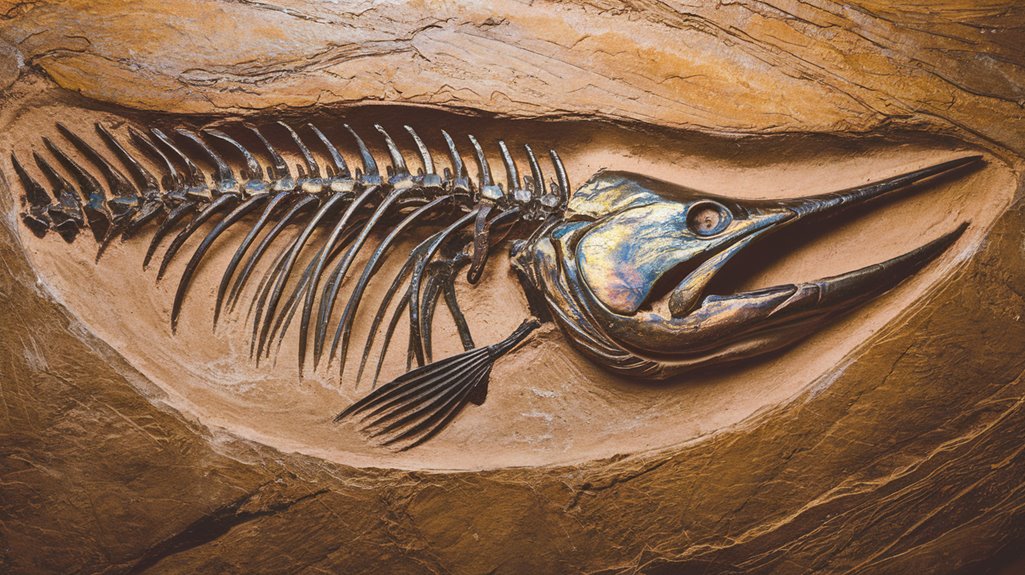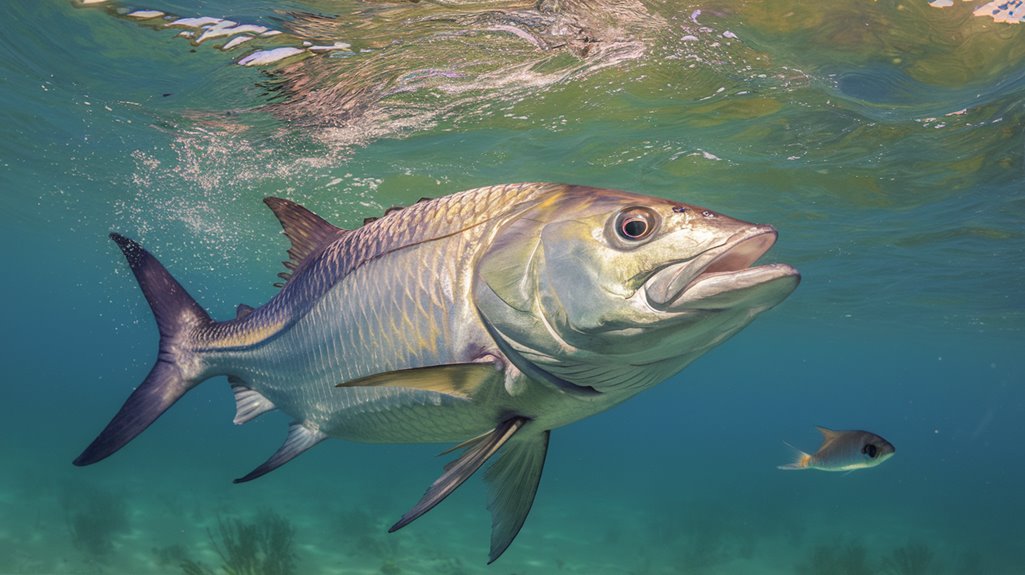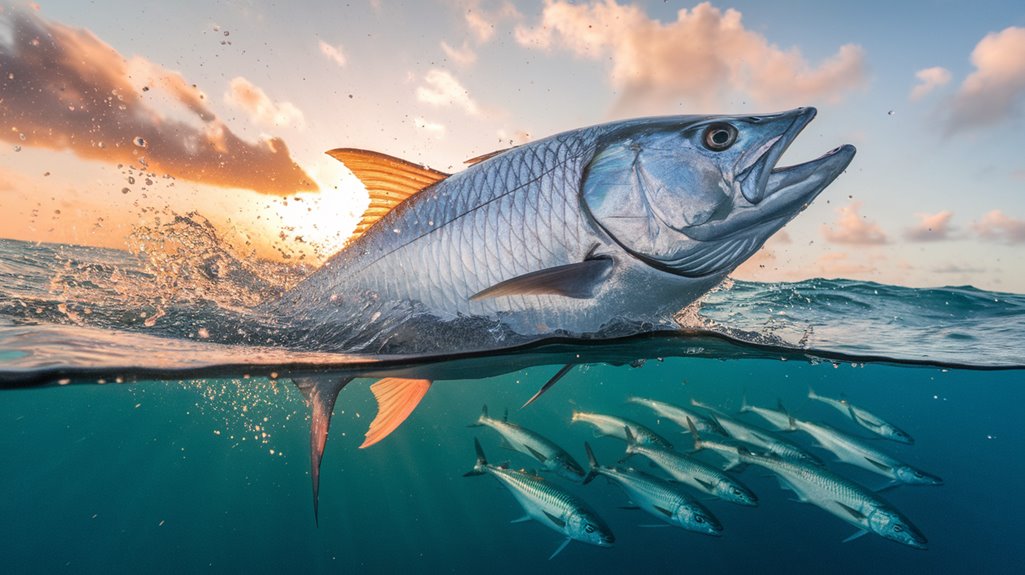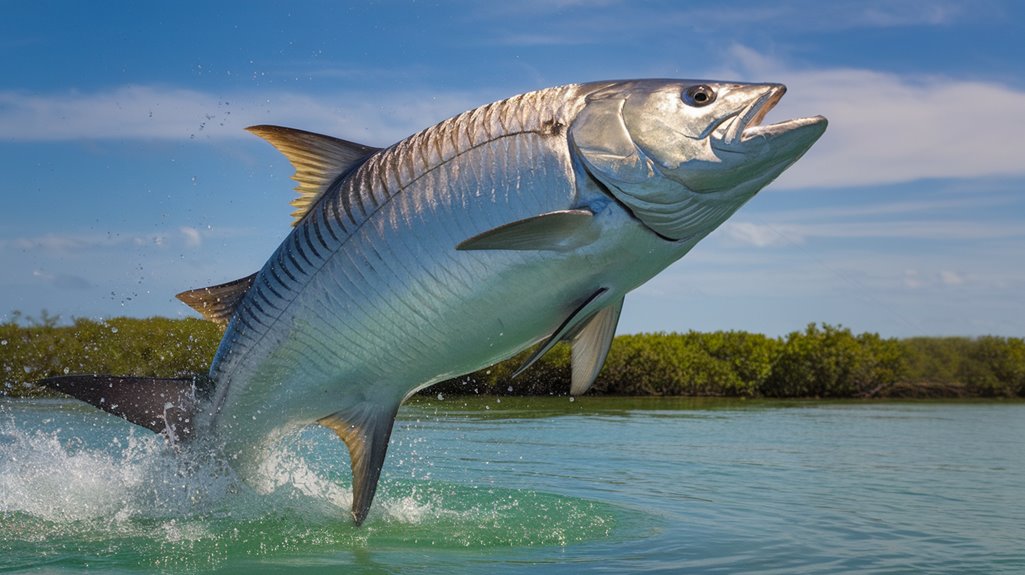You'll discover that tarpon exemplify evolutionary resilience, having survived since the Cretaceous Period with remarkably preserved adaptations. These ancient fish maintain a suite of specialized features, from their upward-oriented eyes to their unique swim bladder modifications. As you examine their complex biology, you'll encounter a species that bridges prehistoric origins with modern survival strategies, setting the stage for an intricate exploration of their physiological and behavioral characteristics.
- Key Takeaways
- Ancient Origins and Evolution of Tarpon
- Physical Characteristics and Adaptations
- Visual Capabilities and Hunting Strategies
- Oxygen Acquisition and Rolling Behavior
- Migratory Patterns and Seasonal Movement
- Spawning Habits and Reproductive Cycles
- Growth Stages and Development
- Habitat Selection and Environmental Preferences
- Population Dynamics and Conservation Status
- Frequently Asked Questions
- Conclusion
Key Takeaways
- Tarpon evolved from ancient ancestors during the Cretaceous Period, with modern Megalops atlanticus emerging around 18 million years ago.
- Their large upward-oriented eyes and specialized reflective cells enable exceptional visual acuity in varying light conditions.
- Tarpon migrate up to 2,000 miles annually, following seasonal temperature patterns and preferring waters around 79 degrees Fahrenheit.
- Development progresses through distinct stages, from larval form to maturity, with females reaching sexual maturity at eight years.
- Advanced respiratory adaptations allow tarpon to thrive in oxygen-depleted environments and colonize diverse aquatic habitats.
Ancient Origins and Evolution of Tarpon

While dinosaurs like Tyrannosaurus rex roamed the Earth during the Cretaceous Period, the ancestors of modern tarpon were already establishing their presence in prehistoric oceans. You'll find that Megalops atlanticus, emerging approximately 18 million years ago, represents a significant milestone in tarpon evolution. This ancient lineage has undergone remarkable adaptive radiation, as evidenced by its sister species Megalops cyprinoides throughout the Indo-West Pacific region. The early development of tarpon, particularly their distinctive leptocephalus larval stage, demonstrates sophisticated evolutionary adaptations to marine environments. Their spawning behaviors in the Gulf of Mexico and Gulf Stream waters reflect millions of years of reproductive strategy refinement. These characteristics highlight how tarpon have maintained their ecological niche while adapting to changing marine conditions throughout their evolutionary history.
Physical Characteristics and Adaptations
You'll observe that tarpon possess remarkable sensory capabilities, with their large upward-oriented eyes providing enhanced visual sensitivity for both diurnal and nocturnal predation. The species' scientific name, Megalops, accurately describes these prominent eyes that enable precise detection of surface prey and potential threats in their aquatic environment. Their armored exterior consists of thick, protective scales and a spineless structure that serves as an effective defense mechanism against predators while maintaining the hydrodynamic efficiency required for their characteristic acrobatic movements.
Sensory and Vision Systems
As evidenced by their scientific name Megalops, tarpon possess remarkably large eyes with sophisticated adaptations that optimize their visual capabilities across varying light conditions. Their vision adaptations enable enhanced visual sensitivity, allowing juveniles to primarily detect dark blue and green wavelengths, while adults can perceive shorter wavelengths for improved prey detection in turbid waters. You'll find specialized reflective cells at the back of their eyes that maximize light capture, particularly beneficial during crepuscular feeding periods. Their feeding strategy is supported by superior upward and forward vision, which not only aids in locating prey but also facilitates their ability to communicate with conspecifics. In addition, these fish can detect ultraviolet light, an adaptation that enhances both their predatory success and social interactions.
Armored Body Features
The distinctive armor-like scales of tarpon represent one of their most remarkable physical adaptations, featuring calcified plates that interlock to form a protective external barrier. You'll observe how these thick scales provide essential defense against predators while maintaining the fish's swimming efficiency. The tarpon's armored body features work in concert with its forked tail, enabling those spectacular acrobatic leaps during feeding and combat scenarios.
Their robust scales don't impede agility; instead, they complement the tarpon's streamlined form. The upturned mouth, positioned advantageously for surface feeding, combines with their keen eyesight to optimize predatory success. Despite lacking spines, these powerful fish compensate through their extensive armor system, which has evolved to balance protection with mobility, allowing them to dominate various aquatic environments.
Visual Capabilities and Hunting Strategies

You'll find tarpon's enhanced eye design, evident in their scientific name Megalops, optimized for exceptional visual acuity in both diurnal and nocturnal conditions. Their specialized retinal structure enables precise detection of prey through heightened sensitivity to blue and green wavelengths in juveniles, while adults can process shorter wavelengths including ultraviolet light. These visual adaptations equip tarpon to execute effective hunting strategies in varying water conditions, from clear coastal waters to turbid estuarine environments.
Tarpon's Enhanced Eye Design
Remarkable adaptations in tarpon eye design facilitate exceptional visual capabilities across diverse lighting conditions and aquatic environments. You'll find their large eyes equipped with specialized reflective cells that maximize light capture, enabling heightened visual sensitivity in turbid waters. These adaptive features support effective prey detection during both diurnal and nocturnal hunting periods.
| Feature | Function |
|---|---|
| Reflective Cells | Enhances light sensitivity |
| UV Detection | Improves prey location |
| Color Perception | Varies by life stage |
The tarpon's sophisticated visual system demonstrates age-specific color perception, with juveniles primarily detecting blue-green wavelengths while adults process shorter wavelengths. Their upward-oriented field of vision, combined with ultraviolet light detection capabilities, optimizes predator avoidance and prey location strategies, ensuring survival across varied aquatic conditions.
Light-Based Feeding Adaptations
Through specialized light-based adaptations, tarpon demonstrate exceptional predatory efficiency across varying illumination conditions. You'll find their Megalops designation aptly describes their large eyes, which possess enhanced visual sensitivity for superior hunting in both clear and turbid waters. These anatomical adaptations enable precise prey detection through upward and forward-oriented vision.
You can observe how their feeding behavior integrates with their visual capabilities, as they've developed sophisticated hunting strategies that account for wavelength detection variations between juvenile and adult stages. Their ability to process blue and green spectrums evolves with age, complementing their oxygen acquisition methods. When you study their surface-rolling behavior, you'll note how it supports their predatory activities, allowing them to maintain hunting efficiency even in low-oxygen environments while maximizing their enhanced visual advantages.
Oxygen Acquisition and Rolling Behavior
Tarpon have evolved a sophisticated dual respiratory system that integrates both gill-based and air-breathing mechanisms. Their unique anatomical configuration connects the gut to a specialized swim bladder containing lung-like tissue, enabling efficient oxygen extraction from atmospheric air. You'll observe this adaptation particularly when tarpon navigate low-oxygen environments where gill respiration alone proves insufficient.
During oxygen acquisition, you'll notice their distinctive rolling behavior, especially prominent at sunrise. This surface-breaking action allows tarpon to replenish their oxygen supply by accessing atmospheric concentrations considerably higher than those available in water. Their physiological adaptability manifests in their capacity to switch between gill respiration and swim bladder oxygen absorption, enhancing their endurance during extended periods of exertion. This dual-system approach exemplifies the species' remarkable evolutionary response to varying environmental demands.
Migratory Patterns and Seasonal Movement

Recent telemetric studies have documented expansive migratory routes of up to 2,000 miles, with individual specimens demonstrating daily movement capabilities of 20 miles. These migratory patterns correlate strongly with seasonal water temperature fluctuations, as tarpon exhibit preference for 79-degree Fahrenheit environments.
During spawning months (May-July), you'll observe these distinctive behaviors:
- Brief excursions to Gulf Stream waters
- Profound descents exceeding 400-foot depths
- Northward migration in late summer
- Southward movement during fall months
Tagging projects have revealed that tarpon overwinter in the Gulf of Mexico, particularly around Louisiana oil rigs, though exact locations remain elusive. Their rolling behavior frequency serves as an indicator of environmental conditions, with decreased activity observed in warmer waters, suggesting temporal displacement from specific regions.
Spawning Habits and Reproductive Cycles
The reproductive cycles of Atlantic tarpon follow precise seasonal and spatial patterns that build upon their migratory behaviors. You'll find these fish engage in offshore spawning activities during May through July, utilizing the Gulf Stream and Gulf of Mexico. Female Atlantic tarpon achieve sexual maturity at approximately 8 years, with larger specimens demonstrating enhanced egg production capabilities and reproductive success.
Through satellite tracking and larval tarpon collection, scientists have verified specific spawning locations. Length-frequency distributions reveal distinct size classes between mature males and females, indicating clear reproductive readiness markers. What's particularly fascinating is how spawning patterns correlate with lunar cycles, influencing the timing of larval development. This synchronization demonstrates the species' evolutionary adaptation to maximize survival rates during their critical early life stages.
Growth Stages and Development
During early development, Atlantic tarpons progress through distinct morphological stages, beginning with notochord lengths of 5.7-8.1 mm in Stage 1. You'll notice significant variations in body dimensions between Atlantic and Pacific species, with Pacific tarpon leptocephali typically entering Stage 2 when fin development and pigmentation become apparent.
Key developmental milestones include:
- Early Stage 1 growth (5.7-8.1 mm NL)
- Post-larval shift at 16.0 mm SL
- Squamation development phase (22.4-33.5 mm SL)
- Established weight vs. length relationships in Stage 2
You'll find these growth stages particularly evident in environments like the Indian River Lagoon, where researchers have documented precise weight-to-length correlations for Stage 2 Atlantic tarpons. This methodical progression through developmental phases characterizes the species' early life history.
Habitat Selection and Environmental Preferences
Moving from developmental stages to habitat dynamics, mature tarpon exhibit highly selective environmental preferences that shape their distribution patterns. You'll find these remarkable fish mainly in warm coastal waters, where they've adapted to thrive in oxygen-depleted environments like mangroves and estuaries. Their habitat selection varies markedly with age: juvenile tarpon gravitate toward brackish waters with reduced salinity, utilizing mangrove-rich areas as protective nurseries. As they mature, you'll observe their shift to deeper channels, particularly during spawning months from May through July when they migrate to the Gulf Stream. Their unique respiratory adaptations, combining gill and swim bladder functions, enable them to colonize environments where oxygen levels fluctuate dramatically. Water temperature plays an essential role, with ideal conditions around 79°F directing their seasonal movements.
Population Dynamics and Conservation Status
While tarpon populations face mounting anthropogenic pressures, extensive DNA sampling and tagging initiatives have revolutionized our understanding of their population dynamics. Through analysis of over 22,000 DNA samples since 2005, you'll find that conservation status monitoring has become increasingly sophisticated, particularly for Atlantic tarpon species.
Key factors affecting tarpon population sustainability:
- Sexual maturity onset at approximately 8 years
- Habitat loss in critical spawning areas
- Overfishing pressure from recreational sectors
- Limited genetic diversity in isolated populations
You're witnessing a paradigm shift in conservation initiatives, where community-based participation has become instrumental in data collection. This collaborative approach, combining DNA sampling with movement pattern analysis, provides critical insights into population structures and helps formulate effective management strategies for both Atlantic and Pacific tarpon species.
Frequently Asked Questions
What Unique Adaptation Do the Tarpon Fish Have?
You'll observe tarpon's distinctive swim bladder containing lung-like tissue that extracts oxygen from air, paired with their specialized upturned mouth, enhanced visual adaptations, and forked tail for superior mobility.
Why Do Tarpons Jump Out of the Water?
You'll observe tarpons jumping to expel excess air, regulate buoyancy, replenish oxygen levels, escape predators, and communicate with other tarpons. Their powerful forked tail enables jumps reaching 10 feet high.
What Is the Behavior of a Tarpon?
You'll observe tarpon executing seasonal migrations of 2,000+ miles, performing surface rolls for oxygen regulation, making deep spawning dives to 400+ feet, and maintaining precise temperature preferences around 79°F.
Why Do Tarpon Come to the Surface?
You'll observe tarpon surface-rolling to extract atmospheric oxygen through their specialized swim bladder, supplementing their respiratory needs when dissolved oxygen levels are insufficient, particularly during dawn periods.
Conclusion
You've explored the intricate evolutionary adaptations of Megalops atlanticus, examining their physiological mechanisms from the modified swim bladder to their specialized guanine-laden retinal cells. Through quantitative analysis of their migratory corridors and reproductive phenology, you've gained insight into their complex life history patterns. These findings underscore the imperative for data-driven conservation protocols to maintain viable populations amid anthropogenic pressures and habitat degradation.

